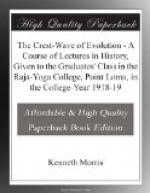But Those who sent out the great six Teachers have a hand to play here: they have to put the welding process through upon their own designs. They start at the fountain of the cyclic impulses, on the eastern rim of the world: as soon as the cycle rises there, they strike for the unification of nations. Then they follow the cycle westward. To West Asia?—Nothing could be done there, because this was the West Asian pralaya; those parts must wait for Mohammed. In Europe then,—Greece?—No; its time and vigor had passed; and the Greeks are not a building people. They must bide their time, then, till the wave hits Italy, and what they have done in China, attempt to do there.
Only, what they had done in China was a mere Ts’in Shi Hwangti,— because Laotse and Confucius had not failed spiritually to prepare the ground,—they must send forth Adept-souled Augustus and Tiberius to do,—if human wisdom and heroism could do it,—in Italy;—because Pythagoras’ Movement had failed.
The Roman Empire was the European attempt at a China; China was the Asiatic creation of a Rome. We call the Asiatic creation, China, Ts’in-a; it may surprise you to know that they called the European attempt by the same name: Ta Ts’in, ’the Great Ts’in.’ Put the words Augustus Primus Romae into Chinese, and without much straining they might read, Ta Ts’in Shi Hwangti. The whole period of the Chinese manvantara is, from the two-forties B.C. to the twelve-sixties A.D., fifteen centuries. The whole period of the Roman Empire, Western and Eastern, is from the forties B.C. to the Fourteen-fifties A.D., fifteen centuries. The first phase of the Chinese Empire, from Ts’in Shi Hwangti to the fall of Han, lasted about 460 years; the Western Roman Empire, from Pharsalus to the death of Honorius, lasted about as long. Both were the unifications of many peoples; both were overturned by barbarians from the north: Teutons in the one case, Tatars in the other. But after that overturnment, China, unlike Rome, rose from her ashes many times, and still endures. Thank the success of Confucius and Laotse; and blame the failure of Pythagoreanism, for that!
But come now; let me draw up their histories as it were in parallel columns, and you shall see the likeness clearly; you shall see also, presently, how prettily time and the laws that govern human incarnation played battledore and shuttlecock with the two: what a game of see-saw went on between the East and West.
From 300 to 250 B.C. there was an orgy of war in which old Feudal China passed away forever, and from which Ts’in emerged Mistress of the world. From 100 to 50 B. C. there was an orgy of war in which Republican Rome passed away forever, and out of which Caesar emerged World-Master. Caesar’s triumph came just two centuries after Ts’in Shi Hwangti’s accession; Kublai Khan the Turanian, who smashed China, came just about as much before Mohammed II the Turanian, who swept away the last remnant of Rome.




